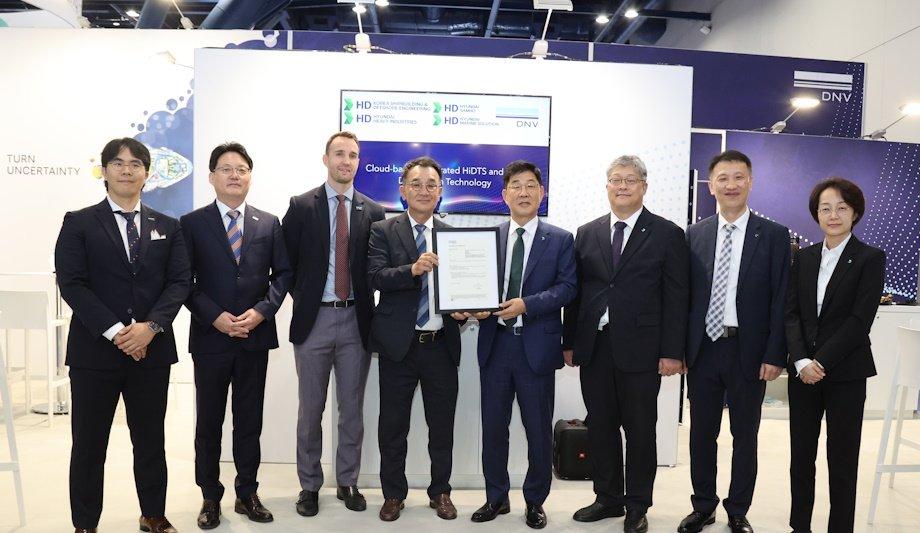At Gastech 2024 in Houston, classification society DNV awarded an Approval in Principle (AiP) to HD Hyundai group for their cloud-based integrated Hyundai Intelligent Digital Twin Ship (HiDTS) system, marking a significant milestone in their three-year collaboration on Data-Driven Verification (DDV) of digital twin technologies.
Since 2022, DNV and Korea Shipbuilding & Offshore Engineering (HD KSOE) have been collaborating on Data-Driven Verification (DDV) of digital twin technologies.
Integrated HiDTS systems
The award marks another significant milestone in the application of DDV to the integrated HiDTS systems
This ambitious three-year project has now been successfully completed, with the award of the Approval in Principle (AiP) in accordance with the DNV class notation DDV, with the DT (digital twin) qualifier.
The award marks another significant milestone in the application of DDV to the integrated HiDTS systems, based on the DNV Simulation Trust Centre (STC) cloud environment in Trondheim, Norway. And is another step towards realising the potential of digital twin technologies in enhancing the efficiency and reliability of maritime operations.
KSOE simulation models
The project was divided into three phases, each focusing on a different system: Phase 01 for the Power Management System (PMS), Phase 02 for the Engine Control System, and Phase 03 for the Gas Management and Cargo Handling (GMS and CHS) systems.
The Approval in Principle (AiP) evaluated the use of KSOE simulation models as the basis for Data Driven Verification (DDV) of these systems through the use of Digital Twin (DT) technology. And as each phase progressed, the additional systems were connected and the scope of the systems covered in the digital twin simulation expanded, with the entire operation managed through an integrated ship system.
Digital twin ecosystem
The new integrated automation system HiCONiS was safely utilised in a vessel and completed sea trials
In September 2024, based on the pilot testing and AiP processes conducted with DNV, the new integrated automation system HiCONiS, pre-validated for LNG carriers, was safely utilised in a vessel and successfully completed sea trials (Hull no. 8196, HD HSHI).
Kwangpil Chang, CTO of HD KSOE, said: “To trust the emerging technology that will be applied to future ships, we need evidence that it is completely secure under all conditions. In this context, the creation of a digital twin ecosystem with DNV is a key part of the ship digitalisation puzzle. We believe our own digital twin technology will contribute to global decarbonisation efforts as well as to the realisation of autonomous ships.”
Advanced future digital ships
Ki-Dong Lee, CEO of HD Hyundai Marine Solution Co Ltd, added: “It is a meaningful step forward for advanced future digital ships. Using digital twins for virtual commissioning is a good way to mitigate the risk of errors and delays."
"Furthermore, digital twin, delivered through the cloud, will be certain to transform the way humans and assets training, as well as their interactions.”
HD Hyundai’s HiDTS system
Vidar Dolonen, Regional Manager DNV Maritime Korea & Japan, commented: “The latest edition of our Maritime Forecast to 2050 highlights the vital role of technology and digitalisation in achieving decarbonization."
"The AiP for HD Hyundai’s HiDTS system showcases how digital twin technology can enhance energy efficiency - supporting the industry's shift towards sustainable shipping and meeting IMO emission targets.”
Usability of digital twin
HD KSOE, HD Hyundai Heavy Industries (HD HHI), HD Hyundai Marine Solution (HD HMS) and DNV will continue their collaboration to assess the usability of digital twin and autonomous technologies, which can be applied to large commercial marine vessels, including compliance with classification rules, international guidelines and the applicable regulations.
Based on the achievements of this project, the collaboration will expand to include different applications, such as crew training services and additional complex and hazardous systems.
